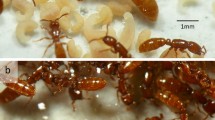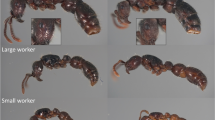Summary
We report here the first detailed account of a member ofPrionopelta, a pantropical genus possessing the smallest workers in the primitive ant tribe Amblyoponini.
-
1.
Colonies ofP. amabilis were found nesting in small rotting logs and tree branches on the floor of primary rain forest in Costa Rica. Two that were more carefully excavated possessed a single dealate queen and a worker population unusually large for Amblyoponini. One of the latter colonies, which was in the process of eclosing alate queens (during late March), contained over 700 workers.
-
2.
P. amabilis workers prey preferentially on campodeid diplurans, although they also accept (less readily) a limited variety of other small arthropods. The prey are given directly to the larger larvae. The queen is fed trophic eggs which we infer to have been laid by the workers.
-
3.
A moderately well-marked temporal division of labor occurs, thus distinguishingP. amabilis fromAmblyopone pallipes, the only other amblyoponine hitherto studied in this regard. Younger workers attend the brood and queen, forming a retinue around the latter individual. Older workers are more active in foraging. As expected, the ovaries are better developed in workers associated with the queen than in foragers.
-
4.
Emigration to nest sites is conducted individually, with the workers carrying brood but not other adult nestmates. A foot-dragging behavior, possibly associated with trail-laying, is described. Alarm pheromones are apparently absent.
-
5.
A unique “wall-papering” behavior was also discovered: the workers line the pupal chambers with fragments of discarded pupal cocoons, rendering these spaces drier and hence presumably more suitable for pupal occupation.
Zusammenfassung
Wir berichten hier die Ergebnisse unserer Studien anPrionopelta amabilis, die erste genauere Untersuchung dieser pantropischen Gattung mit den kleinsten Arbeiterinnen in dem sehr primitiven Tribus Amblyoponini.
-
1.
P. amabilis Kolonien wurden in verfaulenden Holzstämmen und Baumästen am Boden des Regenwaldes von Costa Rica gefunden. Zwei Kolonien, die sehr sorgfältig aus dem Holz abgesammelt wurden, enthielten eine Königin und eine für den Tribus Amblyoponini ungewöhnlich grosse Population von Arbeiterinnen. Eine Kolonie, die auch jungfräuliche Weibchen enthielt, hatte über 700 Arbeiterinnen.
-
2.
P. amabilis erbeutet bevorzugt Dipluren, sie nehmen aber auch einige andere Arthropoden als Beutetiere an. Die Beute wird direkt an die Larven verfüttert. Die Königin erhält trophische Eier, die offensichtlich von den Arbeiterinnen gelegt werden.
-
3.
Eine schwache, doch deutlich erkennbare, Arbeitsteilung zwischen verschiedenen Altersklassen existiert. Damit unterscheidet sichP. amabilis vonAmblyopone pallipes, die enzige andere Amblyoponine, die in dieser Hinsicht untersucht wurde. Jüngere Arbeiterinnen pflegen Brut und Königin. Aeltere Arbeiterinnen sind vorwiegend Futtersammler. Wie zu erwarten sind die Ovarien der Arbeiterinnen, die die Königin pflegen besser entwickelt, als die der Furagierameisen.
-
4.
Soziales Trageverhalten unter adulten Ameisen konnte nicht beobachtet werden. Während Nestemigrationen wird nur die Brut transportiert. Ein merkwürdiges Schleifen der Hintertarsen bei einzelnen Arbeiterinnen könnte dem Spurenlegen oder der Substratmarkierung dienen.
-
5.
Die Nestkammern, in denen Puppen gehalten werden, sind häufig mit alten Puppenkokonteilchen tapeziert. Das dient offensichtlich dazu, die Puppenkammern trockener zu halten.
Similar content being viewed by others
References
Brown W.L., Jr., 1960. — Contributions toward a reclassification of the Formicidae. III. Tribe Amblyoponini (Hymenoptera).Bull. Mus. Comp. Zool. Harvard, 122, 145–227.
Brown W.L. Jr.,Gotwald W.H. Jr.,Lévieux J., 1970. — A new genus of ponerine ants from West Africa (Hymenoptera: Formicidae) with ecological notes.Psyche (Cambridge),77, 259–275.
Hong Y.-C., Yang T.-C., Wang S.-T., Wang S.-E., Li Y.-K., Sun M.R., Sun H.C., Tu N.-C., 1974. — Stratigraphy and paleontology of Fushun coal-field, Liaoning Province.Acta Geol. Sinica, 2, 113–149.
Lévieux J., 1982. — A comparison of the ground dwelling ant populations between a Guinea savanna and an evergreen rain forest of the Ivory coast. In:M.D. Breed, C.D. Michener, andH.E. Evans, eds.,The Biology of Social Insects, pp. 48–51. Westview Press, Boulder, Colo.
Masuko K., 1984. — Studies on the predatory behavior, of Oriental dacetine ants (Hymenoptera: Formicidae). I. some Japanese species ofStrumigenys, Pentastruma, andEpitritus, and a MalaysianLabidogenys, with special reference to hunting tactics in short-mandibulate forms.Ins. Soc., 31, 429–451.
Taylor R.W., 1978. —Nothomyrmecia macrops: A living-fossil ant rediscovered.Science, 201, 979–985.
Traniello J.F.A., 1982. — Population structure and social organization in the primitive antAmblyopone pallipes (Hymenoptera: Formicidae).Psyche (Cambridge),89, 65–80.
Willey R.B., Brown W.L., 1983. — New species of the ant genusMyopias (Hymenoptera: Formicidae: Ponerinae).Psyche (Cambridge),90 249–285.
Wilson E.O., 1955. — Ecology and behavior of the antBelonopelta deletrix Mann (Hymenoptera: Formicidae).Psyche (Cambridge),62, 82–87.
Wilson E.O., 1958. — The beginnings of nomadic and group-predatory behavior in the ponerine ants.Evolution, 12, 24–31.
Wilson E.O., 1985. — Invasion and extinction in the West Indian ant fauna: Evidence from the Dominican amber.Science, 229, 265–267.
Wilson E.O., Carpenter F.M., Brown W.L. Jr., 1967. — The first Mesozoic ants, with the description of a new subfamily.Psyche (Cambridge),74, 1–19.
Author information
Authors and Affiliations
Additional information
Dedicated to WilliamL. Brown, Jr., in recognition of his pioneering work on the Amblyoponini and, through nearly fifty years of research, his many invaluable contributions to the systematics and ecology of ants generally.
Rights and permissions
About this article
Cite this article
Hölldobler, B., Wilson, E.O. Ecology and Behavior of the primitive cryptobiotic antPrionopelta amabilis (Hymenoptera: Formicidae). Ins. Soc 33, 45–58 (1986). https://doi.org/10.1007/BF02224034
Received:
Accepted:
Issue Date:
DOI: https://doi.org/10.1007/BF02224034




